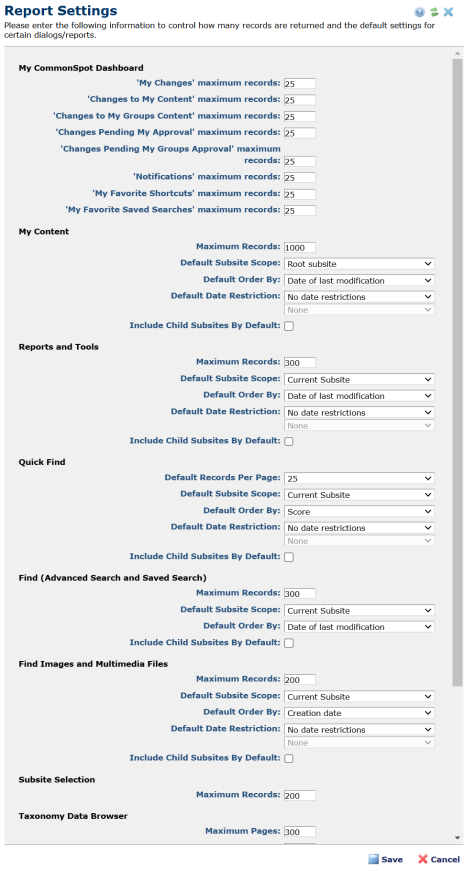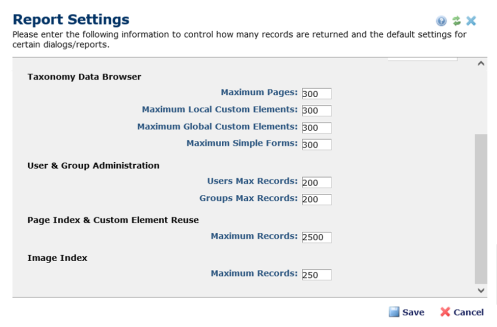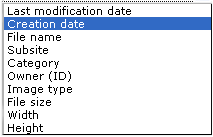Open topic with navigation
Report Settings
CommonSpot contributors can customize the number and type of items that display in their personal My CommonSpot dashboards, as well as set sort and display options for other frequently used dashboard options such as My Content and search results. Use Report Settings to establish defaults for these customizable displays, both to ensure that report results are meaningful and to prevent the system slowdowns that may occur when report criteria require a large number of lookups or produce a large number of results.
For example, displaying every page in a report run against a site with tens of thousands of pages is both unnecessarily resource-intensive and unproductive for individuals trying to locate specific pages or documents.
For sites with a large number of pages, uploaded documents, images, or contributors, this option provides logic to limit the number of items reported.
Use the Site Properties/Settings - Report Settings option to define the default maximums for specific contributor or administrator reports.
Default values display below.


(bottom portion of the dialog)
View or edit the following sections:
My CommonSpot Dashboard:
Controls the number of records returned for each user and group content and approval section, as well as saved searches, shortcuts and notification within My CommonSpot. Enter a numeric value for each field. See Workspace Customization and My CommonSpot for details on how these options display to contributors.
Any attempt to customize reports beyond the maximum standard set here returns a message like the following:

My Content
Controls the number of records returned for reports generated from My Content menu selections and sets default selections for the standard search dropdowns.
Filtering default options for My Content, Reports and Tools, Find, and Find images are similar to options displayed to contributors. Set filtering and ordering defaults, including which subsite levels to include and date restriction behavior.
- Maximum Records: The largest number of records returned for a contributor query or request. Defaults to 300. Enter a number between 0 and 9999, noting that returning a large number of records may degrade performance.
- Default Subsite Scope: Sets the default search or reporting level. Selecting Root subsite defaults to the greatest scope, selecting current subsite a more restricted scope. Select the search level contributors most frequently use.
- Default Order By: Sets the default sort order for results returned.
- Date of last modification - Default sort order is the date of last change.
- Date of last major modification - Default sort order is the date of the last major change. This is an organization-defined option set by treat change as significant during content updates and has no effect on content versioning.
- Date Published - Default sort order is the publication date.
- Title - Default sort order is an alphabetical listing of item titles.
Select the sort order contributors most frequently use.
- Default Date Restriction: Sets default date restrictions for report results. Once contributors select an option, they can further refine a search with This week, This month, This year, Last week, Last month, etc. options.
- No date restrictions - The Select Date Options dropdown defaults to none selected
- Last major modification date - The Select Date Options dropdown defaults to Last Major Modification Date - the last time content was changed with the setting Treat change as significant, an organization-configurable option that has no effect on CommonSpot versioning.
- Creation date- The Select Date Options dropdown defaults to the date content was first created.
- Publication date - The Select Date Options dropdown defaults to the date content will be published.
- Expiration date - The Select Date Options dropdown defaults to the date content expired.
- Include Child Subsites By Default: When selected, autochecks the Include Child Subsites, setting search behavior to include the selected subsite and all the subsites it contains. Users must uncheck to limit search or report results to the current subsite only.
To view how these options display to contributors, see descriptions for individual Reports.
Reports and Tools
Controls the number of records returned for reports generated from the Reports menu and Manage menu options and sets default behavior for standard search dropdowns contained in these reports.
Filtering default options for My Content, Reports and Tools, Find, and Find images are similar to options displayed to contributors. Set filtering and ordering defaults, including which subsite levels to include and date restriction behavior.
- Maximum Records: The largest number of records returned for a contributor query or request. Defaults to 300. Enter a number between 0 and 9999, noting that returning a large number of records may degrade performance.
- Default Subsite Scope: Sets the default search or reporting level. Selecting Root subsite defaults to the greatest scope, selecting current subsite a more restricted scope. Select the search level contributors most frequently use.
- Default Order By: Sets the default sort order for results returned.
- Date of last modification - Default sort order is the date of last change.
- Date of last major modification - Default sort order is the date of the last major change. This is an organization-defined option set by treat change as significant during content updates and has no effect on content versioning.
- Date Published - Default sort order is the publication date.
- Title - Default sort order is an alphabetical listing of item titles.
Select the sort order contributors most frequently use.
- Default Date Restriction: Sets default date restrictions for report results. Once contributors select an option, they can further refine a search with This week, This month, This year, Last week, Last month, etc. options.
- No date restrictions - The Select Date Options dropdown defaults to none selected
- Last major modification date - The Select Date Options dropdown defaults to Last Major Modification Date - the last time content was changed with the setting Treat change as significant, an organization-configurable option that has no effect on CommonSpot versioning.
- Creation date- The Select Date Options dropdown defaults to the date content was first created.
- Publication date - The Select Date Options dropdown defaults to the date content will be published.
- Expiration date - The Select Date Options dropdown defaults to the date content expired.
- Include Child Subsites By Default: When selected, autochecks the Include Child Subsites, setting search behavior to include the selected subsite and all the subsites it contains. Users must uncheck to limit search or report results to the current subsite only.
To view how these options display to contributors, see descriptions for individual Reports.
Quick Find
Controls the number of records returned for reports generated from all Tools - Find- Quick Find operations, and sets default selections for standard search dropdowns contained in these reports.
- Default Records Per Page: Sets the number of records returned for a single Find request. Defaults to 25. Pick from the dropdown of logical increments to select the best number for your site.
- Default Subsite Scope: Sets the default search or reporting level. Selecting Root subsite defaults to the greatest scope, current subsite to a more restricted scope. Select the search level contributors most frequently use.
- Default Order By: Sets the default sort order for results returned.
- Score- Sets the default to relevance-based sort order.
- Date- Default sort order is the date items were released for publication.
- Subsite - Default sort order is organized alphabetically by subsite.
- Title - Default sort order is an alphabetical listing of item titles.
- Document Type - Sorts returned items by file type, by default.
- Default Date Restriction: Sets default date restrictions for report results. Once contributors select an option, they can further refine a search with This week, Last week, This month, or Last month, options.
- No date restrictions: The Select Date Options dropdown defaults to none selected
- Last major modification date - The Select Date Options dropdown defaults to Last Major Modification Date -- the last time content was changed with the setting Treat change as significant, an organization-configurable option that has no effect on CommonSpot versioning.
- Creation date- The Select Date Options dropdown defaults to this option.
Find (Advanced Search and Saved Search)
Controls the number of records returned for reports generated from Tools - Find- Advanced Search and Tools - Find- Saved Searchoperations, and sets default selections for standard search dropdowns contained in these reports.
- Include Child Subsites By Default: When selected, autochecks the Include Child Subsites, setting search behavior to include the selected subsite and all the subsites it contains. Users must uncheck to limit search or report results to the current subsite only.
Find Images and Multimedia Files
Controls the number of records returned for reports generated from all Tools - Find Images and Tools - Find Multimedia. Choose Image operations, and sets default selections for standard search dropdowns contained in these reports.
Filtering default options for Find images and multimedia are similar to options displayed to contributors. Set filtering and ordering defaults, including which subsite levels to include and date restriction behavior.
- Maximum Records: The largest number of records returned for a contributor query or request. Defaults to 300. Enter a number between 0 and 9999, noting that returning a large number of files may degrade performance.
- Default Subsite Scope: Sets the default search or reporting level. Selecting Root subsite defaults to the greatest scope, current subsite to a more restricted scope. Select the search level contributors most frequently use.
- Default Order By: Sets the default sort order for results returned.
- Last modification date- Default sort order is the date of last change.
- Creation date- Default sort order is the date images were first uploaded.
- File name - Default sort order is an alphabetical listing of file titles.
- Subsite - By default, image search results are organized hierarchically by subsite.
- Category - Default sort order is alphabetically organized by defined categories.
- Owner - Order defaults to sorting by image order name.
- Image type - Default sort order is image file type (.gif, .jpeg, .png, etc.)
- File size - Image results are sorted by total file size.
- Width - Image results are sorted by width dimensions.
- Height - Image results are sorted by height dimensions.
- Date of last major modification - Default sort order is the date of the last major change. This is an organization-defined option set by treat change as significant during content updates and has no effect on content versioning.
Subsite Selection
Controls the number of records returned when selecting a subsite.
- Maximum Records: The largest number of records returned for a contributor query or request. Defaults to 300. Enter a number between 0 and 9999, noting that returning a large number of files may degrade performance.
Taxonomy Data Browser
These options limit the number of records displayed for each of these functions. Set limits or accept the current defaults based on the number of records at your site.
- Maximum Records: The largest number of records returned for a contributor query or request. Defaults to 300. Enter a number between 0 and 9999, noting that returning a large number of files may degrade performance.
- Maximum Local Custom Elements
- Maximum Global Custom Elements
- Maximum Simple Forms
User & Group Administration and Page Index & Custom Element Reuse:
These options limit the number of records displayed for each of these functions. Set limits or accept the current defaults based on the number of records at your site.
- User Max Records: The maximum number of users to display.
- Group Max Records - The maximum number of groups to display
Page Index & Custom Element Reuse:
CommonSpot defaults the limit of records displayed for a page index element or custom element to 2500 pages or records.
- Maximum Records: The maxium number of images to display.
Image Index
- Maximum Records: The largest number of records returned for a contributor query or request. Defaults to 300. Enter a number between 0 and 9999, noting that returning a large number of files may degrade performance.
.
At Render Time
- When one of those elements returns more than 2500, the data set is truncated and only the first 2500 are rendered.
- An error is placed in the site error log for reference. Keep in mind that when truncation occurs, the data may not be ordered correctly.
- This feature is designed to prevent a potentially damaging set of filter criteria to display a quantity of records that could jeopardize site performance,or cause a crash.
- The default setting may be increased (not recommended) or decreased (recommended).
Saving Filter Criteria
- Should a filter be saved that would cause the limit set here to be exceeded, a warning will display and prevent saving the filter. Update the filter criteria so that the returned items is less than the setting.
Related Links
You can download PDF versions of the Content Contributor's, Administrator's, and Elements Reference documents from the support section of paperthin.com (requires login).
- Developer's Guide
- Template Developer's Guide
- Shared Database Configuration Guide
- Replication vs Shared Database Guide
Sites upgrading from versions earlier than release 6.0 should review the following (from the support section of paperthin.com - requires login):
- What's New in CommonSpot 6.0
- CommonSpot 6.0.0 Menu Quick Reference
For technical support:
http://www.paperthin.com/support/
Open topic with navigation




